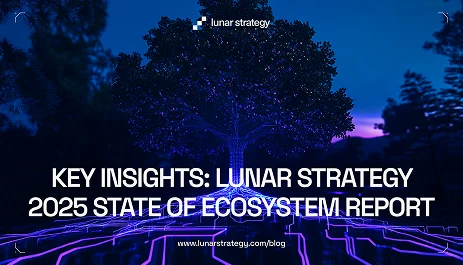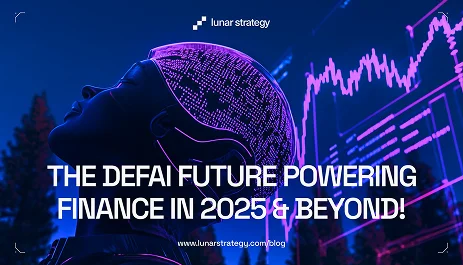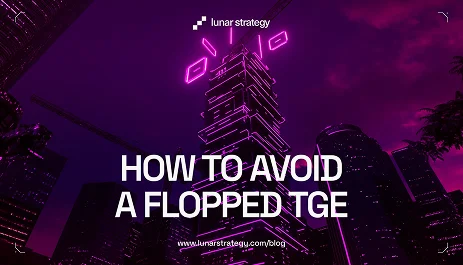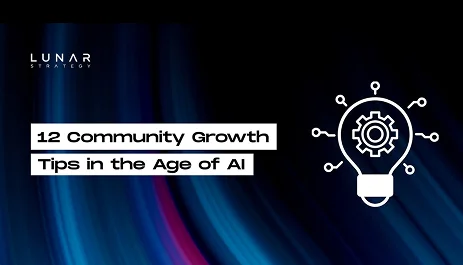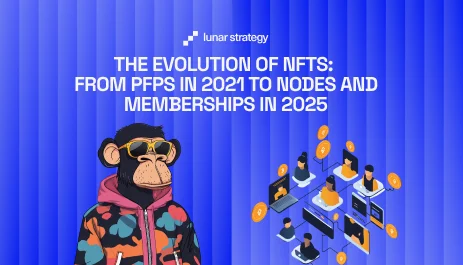If you’re just stepping into crypto, you’ll likely hear that NFTs are at the intersection of finance, tech, art, and internet culture. This phrase hints at a much deeper transformation. NFTs in 2025 have been through (and some would say are still going through) wild narrative rides and unique innovations along the way.
The NFT market is expected to hit USD 264.6 billion by 2032, growing at 28.7% per year from 2024, showing its got a better future ahead unlike what most think of the asset class today.
Not just for speculation anymore—NFTs are now used for everyday things like gaming, supply chains, and digital IDs, making them more practical. Investors are jumping back in, using smart business moves and real-world partnerships, bringing back more excitement and value to the space.
Moreover, NFTs are still used side-by-side with ecosystems like the metaverse, DeFi, and most recently AI projects, making them more appealing.
What are NFTs?
Plainly speaking, NFTs are unique, blockchain-verified digital assets that prove ownership and authenticity while enabling access to real-world utilities, creative monetization, and cross-chain interoperability.
But crypto today is a multichain ecosystem that tackles real-world challenges while giving people new opportunities and ways to monetize their creations. NFTs came into the spotlight with PFP-themed digital art that took the internet by storm. This led to a snowball effect where art drove the rise and innovations surrounding them, as we will explore further below in the article.
With the rise of AI projects, today's artists are not limited to traditional mediums; they are expanding into areas such as video games, movies, and advertising, blending multiple art forms. NFTs can now plug into each of these artforms and help incentivize creator communities and help artists thrive.
But, are NFTs just limited to art on the blockchain? Absolutely not.
Since 2021, non‐fungible tokens have evolved from being merely trendy digital profile pictures into tools with genuine functional value. In their early days, NFTs sparked a wave of enthusiasm in digital art and collectibles, drawing significant public attention. However, as technical innovations progressed and market forces came into play, artists, developers, and investors began to reimagine what NFTs could truly represent.
Today, they serve as instruments for ownership, collaboration, and monetization in a complex, interconnected digital landscape.
A Brief History of NFTs (2021-2025)
NFTs first appeared around 2014, with early experiments like Quantum by Kevin McCoy, but began gaining traction in 2017 with the launch of Ethereum-based projects like CryptoPunks and CryptoKitties.
These early NFTs introduced the idea of digital ownership and scarcity through blockchain, capturing the attention of crypto-native communities. In 2018 and 2019, NFT infrastructure matured with marketplaces like OpenSea launching, while smaller art and gaming projects laid foundational use cases.
By 2020, DeFi’s boom spilled into the NFT space, and niche digital artists began finding new ways to monetize their work. In 2021, NFTs exploded into the mainstream with Beeple’s $69 million Christie’s auction and the meteoric rise of PFP collections like Bored Ape Yacht Club, marking the peak of cultural and financial hype around NFT art and identity.
NFT Mania in 2021
In 2021, the NFT space boomed by becoming a cultural phenomenon when digital artist Beeple’s collage, “Everydays: The First 5000 Days,” sold at Christie’s for over $69 million in March. This sale signaled that art could be digitized and tokenized in a way that attracted both established collectors and a new generation of buyers interested in the emerging decentralized world.
Collections such as CryptoPunks and Bored Ape Yacht Club (BAYC) provided a way for users to adopt a unique digital avatar while serving as a status symbol in the new online culture.
- CryptoPunks, which were created several years earlier, suddenly gained a second life as collectors and enthusiasts began to appreciate the historical and cultural value of possessing one of only 10,000 uniquely generated pixel art characters.
- Bored Ape Yacht Club (BAYC), launched in April 2021, quickly became synonymous with the idea of digital membership. Apart from serving as an avatar, BAYC tokens granted access to private communities and exclusive events.
Collectors (including a-list celebrities) were willing to pay six or seven figures for a single token, and within months these PFP projects dominated much of the NFT trading volume.
How ERC721 Unlocked New Ground for NFTs
The ERC-721 token standard was the technical breakthrough that kickstarted the NFT boom. It gave developers a reliable way to create and manage unique digital assets on Ethereum, laying the groundwork for platforms like OpenSea to emerge.
This standard allowed creators to mint one-of-a-kind items—art, collectibles, even virtual land—with verifiable ownership on-chain. It made NFTs tradable, ownable, and trustworthy, even if most early collectors didn’t understand the code behind it. At the time, the value was mostly tied to aesthetics and digital identity, not utility.
The Rise of Node NFTs
Nodes are the core infrastructure of blockchains, responsible for validating transactions and keeping the network running. Traditionally, these nodes were operated manually and categorized as full or light nodes depending on how much data they processed.
As NFT technology matured—especially with the ERC-721 standard—developers began experimenting with turning node ownership or access rights into tradable NFTs.
This meant users could own a stake in a blockchain’s infrastructure, earning rewards or governance rights without running the hardware themselves. Powered by smart contracts, “node NFTs” automated node interactions and opened up network participation to a broader audience.
We will take a closer look at the Node NFT narrative in a later section below.
The 2022 Boom and Market Correction
In early 2022, the NFT market hit its peak before crashing hard. Monthly sales reached billions, fueled by hype and speculation from 2021, but the momentum was unsustainable.
As crypto markets became more volatile that year—triggered by events like LUNA’s collapse and FTX’s downfall—confidence vanished, and NFT trading volumes dropped over 90 percent. Most collections lost their value, with the majority becoming effectively worthless. By the end of the year, the focus shifted from hype to utility, and the industry began seriously questioning what NFTs were actually good for.
As the NFT market cooled, attention shifted from collectibles to real-world utility. Creators and brands began using NFTs as access passes to communities, events, and future perks, turning tokens into more than just digital art. Some projects added features like staking and airdrops, rewarding holders for participation. Others explored dynamic NFTs that could change over time or respond to data. These early steps hinted at a future where NFTs offered functionality, not just visual appeal.
As NFTs matured, the limitations of ERC-721 became clear—it wasn’t built for scale or versatility. That changed with ERC-1155, introduced in 2019, which let a single smart contract handle multiple token types, both fungible and non-fungible.
This made large-scale minting cheaper and more efficient, opening the door for utility-heavy projects. Gaming platforms like Enjin adopted it to power complex in-game economies with tradable assets. ERC-1155 also laid the groundwork for future innovations like dynamic NFTs and token-bound accounts that began appearing by 2023.
Recalibration in 2023
By early 2023, NFT trading volumes rebounded to roughly $4.7 billion—driven in part by Blur’s airdrop‑fueled high‑volume trading alongside established marketplaces like OpenSea and Magic Eden—while pilots of dynamic NFTs (Lineage’s updatable art layers, Chainlink‑fed sports cards, game characters that level up) showcased how tokens could evolve in response to real‑world data.
At the same time, ERC‑6551 (“token‑bound accounts”) began attaching smart‑wallets to NFTs—enabling “backpack” avatars that hold other assets and log their own histories—bridging static collectibles into self‑contained digital tools. Infrastructure also went on‑chain: Helium compressed hotspot node ownership into Solana NFTs, and “NodeFi” concepts tokenized staking rights for validator slots. Finally, fractional and DeFi‑style NFTs emerged, allowing high‑value collectibles or yield‑bearing positions to be split, used as collateral, or staked for returns, cementing NFTs’ role as programmable financial instruments.
By 2023, NFTs broke free of single‑chain silos as cross‑chain bridges let tokens move seamlessly between Ethereum, Solana, Polygon, BNB Smart Chain, and more—so an NFT minted on one network could tap another’s low fees or high speed without hassle. Marketplaces like Magic Eden and specialized bridges handled the transfers, unlocking new audiences and use cases. At the same time, dynamic NFTs infused token behavior with real‑world data via oracles, and DeFi integrations turned NFTs into collateral or fractionalized assets. These advances cemented NFTs as interoperable, adaptable financial tools rather than static digital collectibles.
While market recovery was gradual, several cultural and creative trends became clear. Major brands and artists had learned from the crash and shifted to models that emphasized value and long-term engagement rather than speculative hype. Collectible art began to come with measurable benefits, where holding an NFT might grant access to future drops, voting rights in community decisions, or even a share in a project’s revenue. This led to a more nuanced market where the narrative was not simply about speculation, but about tangible benefits. It was evident that the hype of 2021 had faded, but the technology had matured, allowing the NFT space to reinvent itself. The focus was on sustainability, real-world utility, and long-term cultural significance.
The NFT Landscape in 2025
In 2025, NFTs aren’t just shiny toys for speculators—they’re useful as hell. Utility is king, and here’s what that looks like:
- Membership and Access: NFTs are similar in utility to VIP passes. Projects like VeeFriends use them to unlock exclusive events or communities. If you hold the token, you’re in the club.
- Gaming: Think in-game gear—weapons, skins, characters. Axie Infinity’s a prime example, where NFTs are stuff you actually use, not just hoard.
- Real-World Assets: They’re tokenizing things like real estate or intellectual property. It’s ownership, but digital, transparent, and easier to trade.
- Governance: Some NFTs let you vote in DAOs—Decentralized Autonomous Organizations. You’re not just a collector; you’re a decision-maker.
The market has matured since its wild 2021–2022 days. Sure, trading volume’s down—OpenSea hit $2.5 billion in 2024 compared to $23 billion in 2021—but it’s steady now. The shakeout killed lazy projects, bad actors, and non-contributors.
Meanwhile, real art, artists, and culture are thriving in web3. Artists drop dynamic, interactive works—stuff that evolves or reacts—and send it on-chain globally. Museums and galleries are also jumping in, using NFTs to pull in new crowds and archive digital art.
The regulatory environment also saw significant improvement by 2024.
Regulations
Governments and regulatory bodies started issuing clearer guidelines concerning digital assets, and platforms took extra precautions to adopt proper audit practices.
Measures to ensure security and privacy of data improved, reducing fraud and reinforcing trust in the NFT space. This regulatory clarity, combined with technological enhancements such as layer-two solutions and improved standards, helped to stabilize the market and foster a more sustainable ecosystem.
Node NFTs in 2025
Unlike traditional NFTs tied to digital art, Node NFTs offer functional value and integrate tightly with projects like Decentralized Physical Infrastructure Networks (DePIN) such as Helium’s IoT connectivity, while also intersecting with broader crypto trends—DeFi expansions and AI‑driven innovations—that enhance their relevance. Although still emergent and not yet mainstream, Node NFTs in 2025 are carving out a niche within the utility‑focused NFT landscape, buoyed by clearer global regulations and stronger security measures that have stabilized the market and fostered trust.
As the industry prioritizes technological innovation and scalability through layer‑two solutions, Node NFTs are well‑positioned for growth in DePIN and related fields, but they must overcome hurdles such as limited adoption, lingering fraud risks, and the need for more cost‑effective, scalable implementations.
NFT Use Cases Across Industries
For digital identity and credentials NFTs are piloted as digital IDs and access passes, ensuring tamper-proof ownership and authenticity for credentials like passports or diplomas.
This extends to healthcare, where NFTs securely store and transfer patient records, maintaining privacy and control, while also tracking pharmaceuticals through the supply chain to prevent counterfeiting.
Similarly, in supply chain and logistics, NFTs authenticate high-value items like luxury wines or handbags, offering a transparent history of ownership and manufacturing through digital twins.
NFTs are transforming sports and fashion by creating unique, tradable digital assets that deepen fan and consumer engagement. In sports, platforms like NBA Top Shot offer NFT-based highlight reels and player cards, while teams issue NFTs for virtual meet-and-greets or fraud-resistant event tickets. In fashion and luxury goods, brands like Gucci use NFTs to verify product authenticity and reduce counterfeiting, while also creating digital fashion items for metaverse environments.
Limited-edition NFT releases, paired with physical products, enhance exclusivity and appeal. Across these industries, NFTs blend digital ownership with real-world value, offering new ways to interact with brands and experiences.
The transformation from a digital fad to a technology with real-world applications is evident in the growth of the artist community. Artists who had initially embraced NFTs for their novelty and market potential eventually began to see the enduring value in creating art that interacts with technology.
Instead of chasing the elusive quick profit, many artists now focus on projects that offer a lasting cultural impact, allowing them to reach a global audience and secure recurring benefits from their work.
Lunar Strategy: Taking NFT Projects Beyond The Hype Cycle
Since 2019, the Lunar Strategy team has spent time and built experience across the NFT marketing space, guiding projects like JPEGvault and Dark Frontiers to standout success by prioritizing utility and community engagement over short-lived hype. We believe digital assets are tools for connection, opportunity, and lasting value.
The approach hinges on building engaged, loyal communities—a strategy that proved vital after the 2022 market correction, where only projects with real substance could survive. Our networks with NFT media like NFTevening, NFT Plazas, and more, plus blockchain networks such as ICP, Polkadot and many others, helped us get a zoomed in view of how narratives shift in the web3 market.
We then craft ecosystems where collectors are invested and communities are built from the ground up.
For JPEGvault, we rolled out influencer campaigns and community events, sparking a 500% surge in social media engagement and a $3 million market cap in five months. With Dark Frontiers, targeted PR and influencer support drove trading volume on Binance past $3 million in just weeks. We turn medium-scale projects into market contenders.
And now, we’d like you to know how we do it. Our free crypto social media guide is built for today’s web3 landscape. You’ll learn to spot, catch, and bend narratives to suit your project needs, how Kaito is spearheading marketing in the industry, and the exact strategies you can apply to stand out in a crowded marketplace!
In the age of AI, we believe in human connection, and so, by bringing together projects and collectors, Lunar Strategy proves that projects can thrive sustainably in a matured web3 market.



























